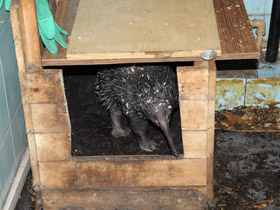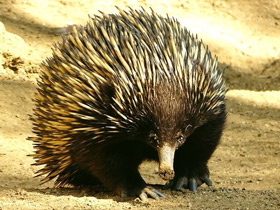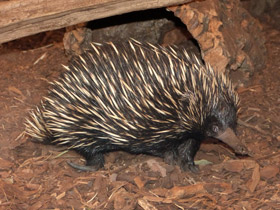The subclass Prototheria
The order Monotremata (Monotremes)
The family Tachyglossidae (Echidnas and spiny anteater)
Prototheria (/ˌproʊtəˈθɪəriə, -toʊ-/; from Greek πρώτος, prōtos, first, + θήρ, thēr, wild animal) is an obsolete subclass of mammals which includes the living Monotremata and to which a variety of extinct groups, including Morganucodonta, Docodonta, Triconodonta and Multituberculata, have also been assigned. It is today no longer considered a valid grouping, but rather a paraphyletic evolutionary grade of basal mammals and mammaliaform cynodonts.
Most of the animals in this group are extinct. The egg-laying monotremes are known from fossils of the Cretaceous and Cenozoic periods; they are represented today by the platypus and several species of echidna.
The prototheria (Prototheria) are a subclass of mammals whose taxonomic hierarchy is controversial, especially in relation to the unranked Australosphenida. It includes mostly fossil species and 5 living species: the platypus (Monotremata, Morganucodonta, Docodonta, Triconodonta) and the four species of echidnas (Multituberculata).
Prototheria is a subclass of primitive mammals that combines characteristics of mammals and synapsids. A single infraclass Cloacales is distinguished in this subclass, unlike the Placental and Marsupial infraclasses of the subclass Bestias. Modern species of Prototheria form a single order, the Monotremes. Prototheria is a small group of species distributed in the Australian region. The subclass Prototheria and Infraclass Cloacales is considered the most archaic and primitive of the infraclasses of mammals because of a number of characteristics.
It has a woolly coat, but homeothermy (maintenance of body temperature at a constant level) is incomplete, with a body temperature ranging from 22 to 37 °C.
Particularities of reproduction
Unlike other mammals, prototheria reproduce by laying eggs, but more than half of the embryo development period takes place in the genital tract of the female. Therefore, the eggs laid contain a well-developed embryo and one can speak not only of oviposition, but also of incomplete live birth.
Females have areas of mammary glands instead of nipples, from which milk is licked by the young. There are no fleshy lips (effective for suckling). Also, like birds and reptiles, they have only one passage.
Habitat area
All species of Cloacales are currently found in Australia, New Guinea and Tasmania. Most species of this subclass are extinct. Egg-bearing monotremes are known from Cretaceous and Cenozoic fossils, currently represented by five species of Cloacales in two families (platypuses and echidnas) and a single order (monotremes). This name is due to the fact that their intestines and urogenital sinus enter the cloaca (similarly in amphibians, reptiles and birds) rather than exiting in separate ducts.
Classification
Subclass Prototheria) / Yinotheria;
- † Division Shuotheridia;
- † Family Shuotheriidae (including Shuotherium);
- Infraclass Australosphenida;
- Genus Asfaltomylos;
- † Genus Ambondro;
- † Division Ausktribosphenidae;
- † Family Ausktribosphenidae;
- Order Monotremata (Monotremata);
- † Family Kollikodontidae;
- Suborder Platypoda;
- Family Platypoda (Ornithorhynchidae);
- Suborder Tachyglossa;
- † Genus Kryoryctes;
- Family Echidnidae (Tachyglossidae).
The order Monotremata (Monotremes)
Monotremes (/ˈmɒnətriːmz/) are mammals of the order Monotremata. They are the only group of living mammals that lay eggs, rather than bearing live young. The extant monotreme species are the platypus and the four species of echidnas. Monotremes are typified by structural differences in their brains, jaws, digestive tract, reproductive tract, and other body parts, compared to the more common mammalian types. Although they are different from almost all mammals in that they lay eggs, like all mammals, the female monotremes nurse their young with milk.
Monotremes have been considered by some authors to be members of Australosphenida, a clade that contains extinct mammals from the Jurassic and Cretaceous of Madagascar, South America, and Australia, but this categorization is disputed and their taxonomy is under debate.
All extant species of monotremes are indigenous to Australia and New Guinea, although they were also present in the Late Cretaceous and Paleocene of southern South America, indicating that they were also present in Antarctica, though remains have not been found there.
The name monotreme derives from the Greek words μονός (monós 'single') and τρῆμα (trêma 'hole'), referring to the cloaca.
Taxonomy
The traditional "theria hypothesis" states that the divergence of the monotreme lineage from the Metatheria (marsupial) and Eutheria (placental mammal) lineages happened prior to the divergence between marsupials and placental mammals, and this explains why monotremes retain a number of primitive traits presumed to have been present in the synapsid ancestors of later mammals, such as egg-laying. Most morphological evidence supports the theria hypothesis, but one possible exception is a similar pattern of tooth replacement seen in monotremes and marsupials, which originally provided the basis for the competing "Marsupionta" hypothesis in which the divergence between monotremes and marsupials happened later than the divergence between these lineages and the placental mammals. Van Rheede (2005) concluded that the genetic evidence favors the theria hypothesis, and this hypothesis continues to be the more widely accepted one.
ORDER MONOTREMATA
- Family Ornithorhynchidae: platypus:
- Genus Ornithorhynchus:
- Platypus, Ornithorhynchus anatinus;
- Family Tachyglossidae: echidnas:
- Genus Tachyglossus:
- Short-beaked echidna, Tachyglossus aculeatus;
- Tachyglossus aculeatus aculeatus (Common short-beaked echidna);
- Tachyglossus aculeatus acanthion (Northern short-beaked echidna);
- Tachyglossus aculeatus lawesii (New Guinea short-beaked echidna);
- Tachyglossus aculeatus multiaculeatus (Kangaroo Island short-beaked echidna);
- Tachyglossus aculeatus setosus (Tasmanian short-beaked echidna);
- Genus Zaglossus:
- Sir David's long-beaked echidna, Zaglossus attenboroughi:
- Eastern long-beaked echidna, Zaglossus bartoni:
- Zaglossus bartoni bartoni;
- Zaglossus bartoni clunius;
- Zaglossus bartoni diamondi;
- Zaglossus bartoni smeenki;
- Western long-beaked echidna, Zaglossus bruijni.
The family Tachyglossidae (Echidnas and spiny anteater)
Echidnas (/ɪˈkɪdnəz/), sometimes known as spiny anteaters, are quill-covered monotremes (egg-laying mammals) belonging to the family Tachyglossidae /tækiˈɡlɒsɪdiː/, living in Australia and New Guinea. The four extant species of echidnas and the platypus are the only living mammals that lay eggs and the only surviving members of the order Monotremata. The diet of some species consists of ants and termites, but they are not closely related to the American true anteaters or to hedgehogs. Their young are called puggles.
Echidnas evolved between 20 and 50 million years ago, descending from a platypus-like monotreme. This ancestor was aquatic, but echidnas adapted to life on land.
Etymology
Echidnas are possibly named after Echidna, a creature from Greek mythology who was half-woman, half-snake, as the animal was perceived to have qualities of both mammals and reptiles. An alternative explanation is a confusion with Ancient Greek: ἐχῖνος, romanized: ekhînos, lit. 'hedgehog, sea urchin'.
Appearance and nutrition
Tachyglycosides are covered with coarse wool and needles. Their maximum body length is approximately 30 cm. Their lips are beak-shaped. The limbs of Tachyglossidae are short and fairly strong, with large claws that allow them to dig well. Tachyglossidae have no teeth and a very small mouth. Their diet consists mainly of termites and ants, which echidnas catch with their long sticky tongue, as well as other small invertebrates, which they crush in their mouths by pressing against their palate with their tongues.
Lifestyle and behaviour
Apart from the winter breeding season, Tachyglossidae live as solitary individuals for most of the year. Each individual guards its own territory in which it hunts. Tachyglossidae have no permanent shelter. Despite their thick and clumsy bodies, Tachyglossidae are good swimmers and can swim through large bodies of water.
Tachyglossidae have keen eyesight and are able to detect the slightest movement around them. In case of any threat, Tachyglossidae quickly hide in bushes or rock crevices. In the absence of these natural shelters, Tachyglossidae quickly burrow into the ground and only a few needles remain on the surface. If the terrain is open and the ground is hard, echidnas simply curl up like a hedgehog. Very few predators can cope with this protection: skilful dingo dogs and foxes can kill an adult echidna by trapping it on a hard, even surface and attacking on the belly side (the ball, in which the echidna curls up, is not full). Young echidnas are also sometimes hunted by monitor lizards.
Reproduction
A female Tachyglossidae lays a single soft-shelled egg three weeks after fertilisation and places it in her pouch. Incubation" lasts ten days. After hatching, the hatchling feeds on milk, which it secretes through the pores of the two milk fields (monotremes do not have teats), and remains in the mother's pouch for 45-55 days until it starts to develop needles. The mother then digs a den for the calf where she leaves it, returning every 4-5 days to feed it with milk. A young echidna is cared for by its mother until it is seven months old.
Threats
Echidnas are very timid. When frightened, they attempt to partially bury themselves and curl into a ball similar to a hedgehog. Strong front arms allow echidnas to dig in and hold fast against a predator pulling them from the hole.
Their many predators include feral cats, foxes, domestic dogs, and goannas. Snakes pose a large threat when they slither into echidna burrows and prey on the spineless young puggles.
They are easily stressed and injured by handling. Some ways to help echidnas include picking up litter, causing less pollution, planting vegetation for shelter, supervising pets, reporting hurt echidnas, and leaving them undisturbed.
Taxonomy
Echidnas are a small clade with two extant genera and four species. The genus Zaglossus includes three extant and two fossil species, with only one extant species from the genus Tachyglossus.
Zaglossus
The three living Zaglossus species are endemic to New Guinea. They are rare and are hunted for food. They forage in leaf litter on the forest floor, eating earthworms and insects. The species are:
- Western long-beaked echidna (Z. bruijni), of the highland forests;
- Sir David's long-beaked echidna (Z. attenboroughi), discovered by Western science in 1961 (described in 1998) and preferring a still higher habitat;
- Eastern long-beaked echidna (Z. bartoni), of which four distinct subspecies have been identified.
The one fossil species is:
- †Zaglossus robustus.
Tachyglossus
The short-beaked echidna (Tachyglossus aculeatus) is found in southern, southeast and northeast New Guinea, and also occurs in almost all Australian environments, from the snow-clad Australian Alps to the deep deserts of the Outback, essentially anywhere ants and termites are available. It is smaller than the Zaglossus species, and it has longer hair.
Despite the similar dietary habits and methods of consumption to those of an anteater, there is no evidence supporting the idea that echidna-like monotremes have been myrmecophagic (ant or termite-eating) since the Cretaceous. The fossil evidence of invertebrate-feeding bandicoots and rat-kangaroos, from around the time of the platypus–echidna divergence and pre-dating Tachyglossus, show evidence that echidnas expanded into new ecospace despite competition from marsupials.
Additionally, extinct echidnas continue to be described by taxonomists;
Megalibgwilia
The genus Megalibgwilia is known only from fossils:
- Megalibgwilia owenii from Late Pleistocene sites in Australia;
- Megalibgwilia robusta from Miocene sites in Australia.
Murrayglossus
The genus Murrayglossus is known only from fossils:
- Murrayglossus hacketti (previously classified in the genus Zaglossus) from Pleistocene of Western Australia.


















































